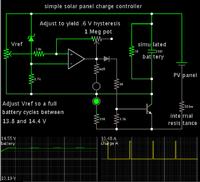vbdev
Member level 1

- Joined
- Jul 21, 2012
- Messages
- 32
- Helped
- 1
- Reputation
- 2
- Reaction score
- 1
- Trophy points
- 1,288
- Activity points
- 1,554
While I was searching for a solar charge controller design I came across this one.

I am specially impressed because n-channel mosfet is used, which are commonly available. Most other design use p-channel mosfets.
My query is that how the battery terminal voltage is monitored? I think R1 should be connected to the cathode of D1. Please help whether the circuit design is alright or there is some error.

I am specially impressed because n-channel mosfet is used, which are commonly available. Most other design use p-channel mosfets.
My query is that how the battery terminal voltage is monitored? I think R1 should be connected to the cathode of D1. Please help whether the circuit design is alright or there is some error.





